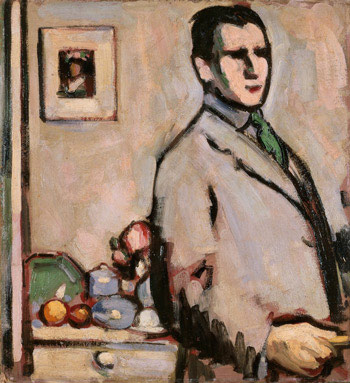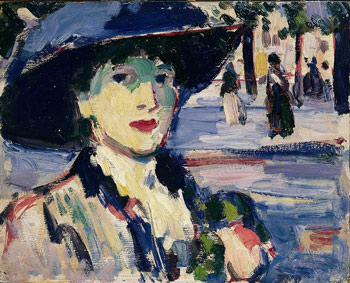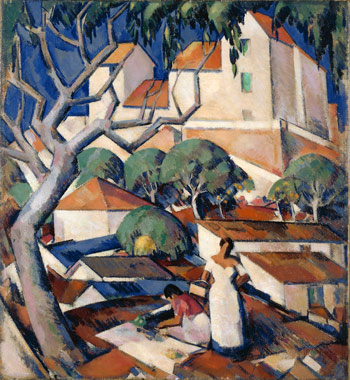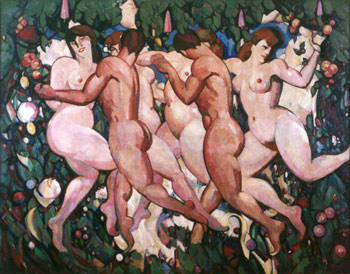Colour, Rhythm and Form: J. D. Fergusson and France
Introduction
Colour, Rhythm and Form: J. D. Fergusson and France
10 September 2011 - 8 January 2012
Hunterian Art Gallery
Admission £5.00 (£3.00 concession)
Joint Ticket (includes admission to The Mackintosh House) £8.00 (£5.00 concession)
This exhibition is a must-see for anyone with an interest in Scottish art history. It will also make your feet tingle and your heart race. Jan Patience, The Herald
France was of vital importance for the Scottish Colourist painter J. D. Fergusson (1874 –1961) as inspiration, studio and home. This leaflet accompanies the exhibition which explores the story of that relationship, marking the 50th anniversary of Fergusson’s death.
J. D. Fergusson is one of Scotland’s most important 20th century artists. His lifelong engagement with France began with trips to Paris in the 1890s when art in the city was changing radically. Responding first to work by the Impressionists, Fergusson was soon absorbing the new ways of looking at the world pioneered by Cézanne, Matisse and the Fauves who were painting to stimulate the senses and suggest rhythm and movement through changing viewpoints or by the use of vivid colour. He would visit galleries, from large public institutions such as the Louvre to small commercial ones on the Left Bank. Defiantly self-taught, he avoided formal artistic instruction, sometimes attending life classes but preferring to observe life and paint outside.
Fergusson’s true university was Parisian café society, which at the turn of the 20th century was a ferment of ideas in art, literature, philosophy, music and dance. This camaraderie and creativity was something Fergusson tried to recreate in later years in London and in Glasgow. From Paris, Fergusson graduated to the South of France where the colour and subject matter he found there informed his painting and sculpture for the rest of his career.
Throughout his life, whether he lived and worked in Paris, Antibes, London or Glasgow, Fergusson’s art was infused by his rebellious, independent nature, his belief in freedom of expression and his commitment to a modern, non-academic art world.
Image: J. D. Fergusson, Self Portrait, 1907 © The Fergusson Gallery, Perth and Kinross Council
Scotland to Paris
From Scotland to Paris
J. D. Fergusson was born in Leith, Edinburgh, on 9 March 1874. He was a gifted school-boy sketcher. He began to study medicine but dropped out in the second year resolving to take his talent seriously and become an artist. 
Fergusson was inspired by the work of the Glasgow Boys, the circle of artists who had introduced ideas relating to modern French painting to Scotland in the 1880s and 90s. Arthur Melville was particularly important for Fergusson and he followed in his footsteps, visiting and painting France, Morocco and Spain. Other major early influences included Whistler, Velasquez, Degas and Manet.
Friendship with artist and fellow Scot Samuel John Peploe (1871–1935) was an important stimulus for Fergusson. From around 1900 the two artists began to make regular summer trips to Paris and the fashionable coastal resorts of Brittany and Normandy. The artists saw Impressionist paintings in Paris and made their own efforts to focus on the subject matter of modern life and to capture the fleeting effects of light.
Fergusson settled in Paris in 1907. He constantly sought out new art in the city and became part of a friendly circle of artistic people, meeting at the cafés, crèmeries and bistros around bohemian Montparnasse. Pablo Picasso, André Derain and André Dunoyer de Segonzac were among his acquaintances.
Image: J. D. Fergusson, Anne Estelle Rice in Paris, Closerie des Lilas, 1907 © The Fergusson Gallery, Perth and Kinross Council.
The South of France
The South of France
After a number of summers in Brittany, in 1913 Fergusson and Peploe holidayed in Cassis. Fauvist and Expressionist artists in pursuit of intense colour were discovering the South of France. It was cheap to live, the food and wine were good and it was warm and bright. 
Fergusson settled on the Cap d’Antibes, then a quiet backwater, deserted in summer. He had met the young English dancer Margaret Morris in Paris. In one of his first letters to her he wrote:
‘… the place here has given me a new start, a different feeling altogether about painting, or rather it has given me what I’ve been trying to make out of nothing – the colour, the shapes, everything that I was developing by sheer sweat and labour is here. The light that one snatched with excitement when it happened once in a blue moon, is here even in winter.’
The outbreak of the Great War in 1914 forced Fergusson to return to Britain, where he renewed contacts with Peploe and the London and Scottish art scenes. He also met Leslie Hunter and Francis Cadell for the first time. As soon as the war was over, in 1918, Fergusson resumed his visits to the South of France which continued to provide the main subject matter for his paintings.
Image: J. D. Fergusson, Christmas Time in the South of France, 1922 © The Fergusson Gallery, Perth and Kinross Council.
Paris Exhibitions
The Paris Exhibitions
In the 1920s his work was exhibited in Glasgow, Edinburgh, London, Paris, New York and Chicago. Although the term ‘Scottish Colourist’ was not used until much later, the work of Fergusson, Peploe, Hunter and Cadell was exhibited together for the first time, as Les Peintres de l’Écosse Moderne (Modern Scottish Painters) at the Galerie Barbazanges, Paris in June 1924. In March 1931, the four artists showed together in Paris again at the Galeries Georges Petit. On the opening day of the exhibition the French Government bought work by Fergusson, Peploe and Hunter for the French National Art Collection, a real accolade for the artists and for Scottish art. The exhibition brings these three works together for the first time in Britain. 
From Antibes to Glasgow
In 1939, conscious of the growing tensions across Europe, Fergusson cleared his studio in Antibes and decided to settle in Glasgow. He felt it was time to help younger Scottish artists and play an active part in establishing a distinct Scottish art.
Ultimately what Fergusson brought from France to Scotland was a belief in freedom of expression in art achieved through comradeship, discussion, a vibrant arts scene and the cross-disciplinary exchange of ideas:
‘One of the chief characteristics of modern painting is free thinking and free expression.’
Fergusson died in January 1961, at the age of 86, at home in Clouston Street, Glasgow, having spent a last summer in Antibes.
Image: J. D. Fergusson, Les Eus, c 1910 © The Fergusson Gallery, Perth and Kinross Council.
Further Information
Further Information
The Fergusson Gallery, Marshall Place, Perth PH2 8NS
Fergusson related merchandise is available in the Art Gallery shop.
Further reading and information:
Louise Annand, J.D. Fergusson in Glasgow 1939-1961, Abingdon 2003
Roger Billcliffe, The Scottish Colourists, London 1989 (2000)
Anne Dulau, Selina Skipwith, Intimate Friends: Scottish Colourists from the Hunterian Art Gallery and The Fleming Collection, London 2003
Philip Long, Elizabeth Cumming, The Scottish Colourists 1900-1930, Edinburgh 2000
Margaret Morris, The Art of J.D. Fergusson: A Biased Biography, Glasgow and London 1974
Kirsten Simister, Living Paint: J. D. Fergusson 1874–1961, Edinburgh 2001
The Hunterian would like to thank all the lenders to the exhibition:
Centre Pompidou, Paris: Musée national d’art moderne
Andrew Cherniavsky
Lady Clark
The Fergusson Gallery, Perth and Kinross Council
Glasgow University Library
The McManus, Dundee City Council Museums
Professor Alan Riach
University of Stirling Art Collection
Colour, Rhythm and Form: J. D. Fergusson and France
10 September 2011 - 8 January 2012
Open Tuesday - Saturday, 10.00am - 5.00pm and Sunday, 11.00am - 4.00pm
Admission £5.00 (£3.00 concession)
The Hunterian (Art Gallery)
University of Glasgow
82 Hillhead Street
Glasgow G12 8QQ
Telephone +44(0)141 330 5431
The University of Glasgow, charity number SC004401
J. D. Fergusson, La Déesse de la Rivière, c. 1928. © The Fergusson Gallery, Perth and Kinross Council. Photo © Collection Centre Pompidou, Dist. RMN / Jean-Claude Planchet.
Events
Colour, Rhythm and Form 10 Minute Talks
Tuesdays 20 September, 18 October and 22 November 2011
1.00pm
Hunterian Art Gallery
Special 10 minute lunchtime talks about the ‘Colour, Rhythm and Form’exhibition. Admission included in exhibition ticket price.
Research Forum Symposium: Colour, Rhythm and Form: J. D. Fergusson and France
29 September 2011
2.30pm - 8.00pm
Hunterian Art Gallery Lecture Theatre
Organised by History of Art and The Hunterian, this symposium is primarily for students taking Research Forum (HISTART5095) but open to all interested postgraduates in the College of Arts. For further information visit www.gla.ac.uk/schools/cca/events/
Institute for Art History Public Lecture
29 September 2011
5.30pm - 8.00pm
Hunterian Art Gallery Lecture Theatre
‘J.D. Fergusson in Context’ by Dr Tom Normand, University of St Andrews. All welcome. Visit www.gla.ac.uk/schools/cca/events/ for further details. This event is supported by the School of Culture and Creative Arts, University of Glasgow.
Saturday Art Corner
5 November - 10 December 2011
Hunterian Art Gallery
A six-week course of creative arts activities for kids inspired by our special exhibition ‘Colour Rhythm and Form’. 10.00am - 12.00pm for ages 5 - 7 years and 1.00pm - 3.00pm for ages 8 - 12 years. £48.00 for the six-week course. Booking essential. For details or to book call 0141 330 2375 or email hunterian-education@glasgow.ac.uk
Colour, Rhythm and Form: J. D. Fergusson in France - In conjuction with Alliance Francaise de Glasgow: French Language tours with Curator, Anne Dulau
11 October and 8 November 2011
1.00pm - 2.00pm
Hunterian Art Gallery
Tickets £3.00 in advance through Alliance Francaise Language Office on 0141 331 4080 or admin@afglasgow.org.uk
Visit www.afglasgow.org.uk for further details.
Colour, Rhythm and Form: J. D. Fergusson in France and Scotland
26 November 2011
10.00am - 4.00pm
Hunterian Art Gallery Lecture Theatre
A one-day symposium organised by the Department for Adult and Continuing Education (DACE) examining Fergusson's contribution to art in Britain and France. Tickets £24.00 (£14.00 for full-time University of Glasgow undergraduate and postgraduate students). For further details or to book contact DACE on 0141 330 1835.

